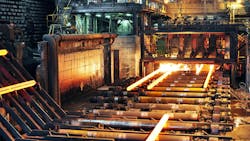ArcelorMittal and Utility Global Collaborate on Hydrogen Innovation at Brazilian Steel Plant
Global steel producer ArcelorMittal will work with Utility Global to plan for producing hydrogen and on-site power at a large Brazilian mill.
Utility Global has created a patented H2Gen hydrogen reactor technology, which it hopes to deploy at the Juiz de Fora steel facility in Minas Gerais, Brazil. The system is designed to utilize blast furnace off-gas as the energy source to create hydrogen from water.
The work with Utility Global will aim to create essentially a circular energy system within the Juiz de Fora steel plant. H2Gen will separate the hydrogen from water, while the concentrated carbon dioxide (CO2) stream will be captured and stored. The H2 produced on-site can be recirculated into the steelmaking process to cut down on CO2-intensive natural gas fuel, according to the companies.
"This project represents a shared commitment to scaling business and technology innovation that supports global energy transition goals," said Parker Meeks, CEO at Utility, in a statement. "We're proud to bring our H2Gen solution to the forefront of industrial business advancements in partnership with one of the world's most forward-thinking steel producers, who is also an investor in Utility Global."
Hydrogen does not contain carbon in its molecular chain and does not emit CO2 at the point of use. However, separating H2 at industrial scale requires processes such as steam reforming of methane natural gas, which is carbon intensive, or electrolyzers separating the hydrogen from water.
Hydrogen which is separated from emissions-intensive technologies but coupled with carbon capture is often referred to as “blue hydrogen.” Green hydrogen is H2 separated from water by electrolyzers which are powered by carbon-free generation such as solar, wind, nuclear or hydropower.
Powering the Future: Exploring Potential of H2
New White Paper by Cummins
The H2Gen plan at ArcelorMittal’s Brazilian steel plant is not a done deal. Utility Global will lead early engineering stages to determine the technical and economic feasibility of deploying the hydrogen system on the site.
If and when it does become operational, the H2Gen at Juiz de Fora could produce up to three metric tons of blue hydrogen per day from the blast furnace off-gas. Hydrogen is the most abundant element on earth and its energy density is comparable to natural gas.
ArcelorMittal has invested $5 million in Utility Global through the steelmaker’s XCarb Innovation Fund. The fund was launched in 2021 to support companies working on decarbonization technologies for the steel industry.
The steel industry has announced ambitious goals for decarbonizing operations, but progress so far has been slow compared to other sectors.. A report on global efforts at industrial decarbonization by non-profit Mission Possible Partnership (MPP) indicated that the steel and cement industries were losing ground and meeting only 9% of their goals for lower emitting production plants reaching final investment decisions (FID) or operations.
The global aluminum industry, by contrast, was most successful at making decarbonization progress with 57% of planned low-carbon refineries and smelters reaching FID or operations, according to MPP.
ArcelorMittal is one of the world’s major steelmakers. The company’s in-house decarbonization production strategies have included the Carbalyst pathway of capturing and re-using the carbon emission waste to produce chemical products.
“Steel is already the material of choice due to its lower carbon footprint and high recyclability,” CEO Aditya Mittal was quoted on the company’s climate-action webpage. "But we can and must go further as zero carbon-emissions steel has the potential to be the backbone of the buildings, infrastructure, industry and machinery, and transport systems that will enable governments, customers and investors to meet their net-zero commitments.”
In its first-quarter 2025 earnings report, ArcelorMittal indicated its decarbonization pathway was showing strong financial returns with a capital expenditure averaging close to $5 billion of investment.
(Editor's Note: Microgrid Knowledge and EnergyTech.com are both part of Endeavor Business Media and focused on the commercial, industrial and mission-critical customer side of the energy transition).
H2 Infinity and Beyond
The free EnergyTech E-Book on Global Hydrogen Moves by C&I
About the Author
Rod Walton, Microgrid Knowledge Head of Content
Managing Editor
For Microgrid Knowledge editorial inquiries, please contact Managing Editor Rod Walton at [email protected].
I’ve spent the last 15 years covering the energy industry as a newspaper and trade journalist. I was an energy writer and business editor at the Tulsa World before moving to business-to-business media at PennWell Publishing, which later became Clarion Events, where I covered the electric power industry. I joined Endeavor Business Media in November 2021 to help launch EnergyTech, one of the company’s newest media brands. I joined Microgrid Knowledge in July 2023.
I earned my Bachelors degree in journalism from the University of Oklahoma. My career stops include the Moore American, Bartlesville Examiner-Enterprise, Wagoner Tribune and Tulsa World, all in Oklahoma . I have been married to Laura for the past 33-plus years and we have four children and one adorable granddaughter. We want the energy transition to make their lives better in the future.
Microgrid Knowledge and EnergyTech are focused on the mission critical and large-scale energy users and their sustainability and resiliency goals. These include the commercial and industrial sectors, as well as the military, universities, data centers and microgrids. The C&I sectors together account for close to 30 percent of greenhouse gas emissions in the U.S.
Many large-scale energy users such as Fortune 500 companies, and mission-critical users such as military bases, universities, healthcare facilities, public safety and data centers, shifting their energy priorities to reach net-zero carbon goals within the coming decades. These include plans for renewable energy power purchase agreements, but also on-site resiliency projects such as microgrids, combined heat and power, rooftop solar, energy storage, digitalization and building efficiency upgrades.

